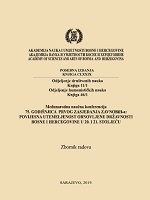SPONE I SPOROVI: BOSNA I HERCEGOVINA U JUGOSLAVENSKOJ DRŽAVI (1918-1941)
BONDS AND DISPUTES: BOSNIA AND HERZEGOVINA IN THE YUGOSLAV STATE (1918-1941)
Author(s): Safet Bandžović
Subject(s): History of Law, Constitutional Law, Political history, Nationalism Studies, Pre-WW I & WW I (1900 -1919), Interwar Period (1920 - 1939), WW II and following years (1940 - 1949)
Published by: Akademija Nauka i Umjetnosti Bosne i Hercegovine
Keywords: Kingdom of SHS; Bosnia and Herzegovina/Yugoslavia; interior constitution; Bosnia and Herzegovina; national ideologies; political discussions; unitarism; federalism; autonomy;
Summary/Abstract: Creation of the Yugoslav state in 1918, which Bosnia and Herzegovina joined as an historical and political subject, meant unification of national, religious, cultural, historical, social, economic, regional differences and perspectives, ties of different national histories, experiences, traditions, customs, mentalities, way of education and living. Being together is not the same as being the same. It was the result of international circumstances, a new toponym, complex state on the map of new Europe, made of different ethnic groups (recognized Serbs, Croats and Slovenes), national and religious minorities who entered the new state with different political, cultural and civilisational ideas. Yugoslavia was standing on unstable political and economical foundations. Having an regime that identifies opinions of the opposition as anti-state action caused resistance against the idea of a new Yugoslav state. Political violence and dictatorship marked the period of existence of Yugoslavia. Conflict between antagonistic supporters of how should the state look like was its biggest inner problem. After 1918, Bosnia and Herzegovina preserved its autonomy with its National government until 1921 and the Provincional government. The Provincional government functioned until 1924 when due to the changes brought by the Vidovdan Constitution (1921) centralization and new inner structure took place. Bosnia and Herzegovina was divided into six regions which were seperate and depedent on the government in Belgrade. With the goal of destroying old historical provinces, new administrative units were formed – banovinas. Bosnia and Herzegovina was in 1929 divided by the Drina, Vrbas, Littoral and the Zeta Banovina. Her status was depedent by the projections of the regime, and by the Serbian-Croatian agreements and problems in their relations which were manifested with the formation of the Banovina of Croatia in 1939. and determination of its borders. Same things occured during talks about the future inner structure of Yugoslavia. Serb and Croat politicans were not ready to accept the formation of a “Bosnian banovina” as it was requested by Muslim politicians. The legacy of several attempts to finally define the inner structure of the country had huge influence in conflicts and in partition of occupied Yugoslavia in 1941.
- Page Range: 57-92
- Page Count: 36
- Publication Year: 2019
- Language: Bosnian
- Content File-PDF

